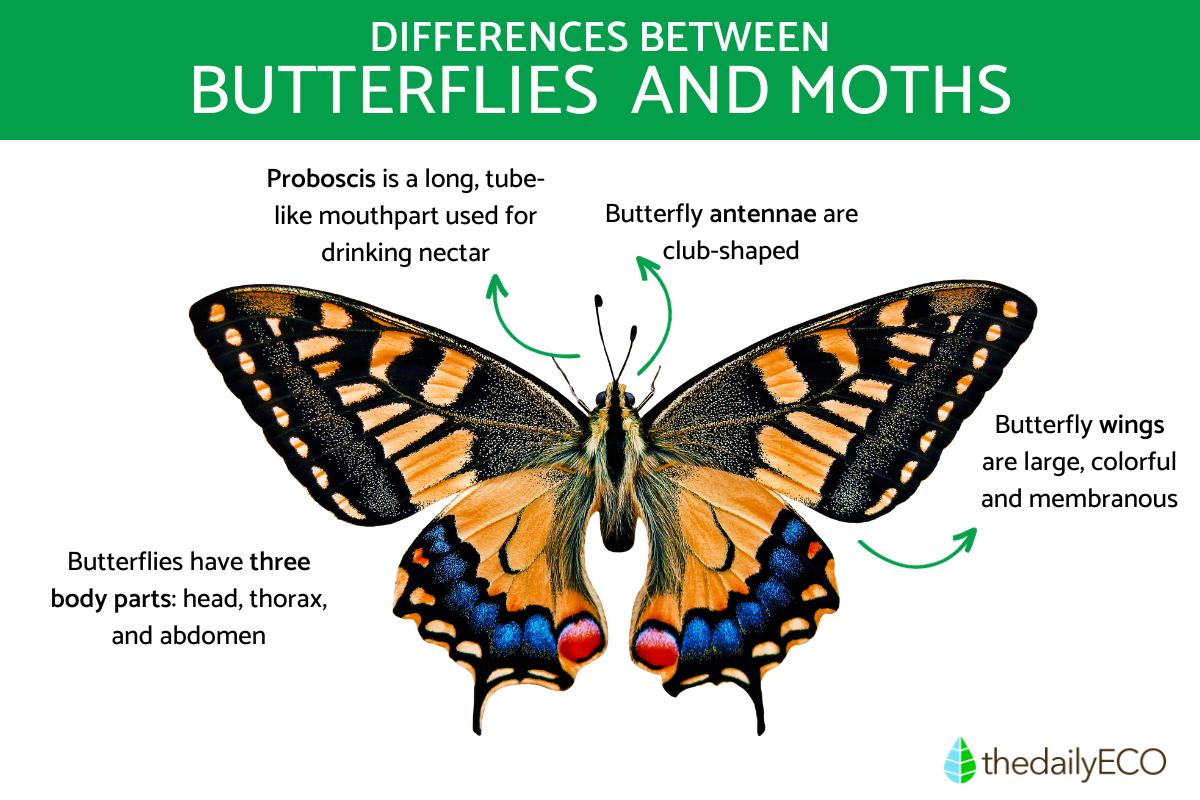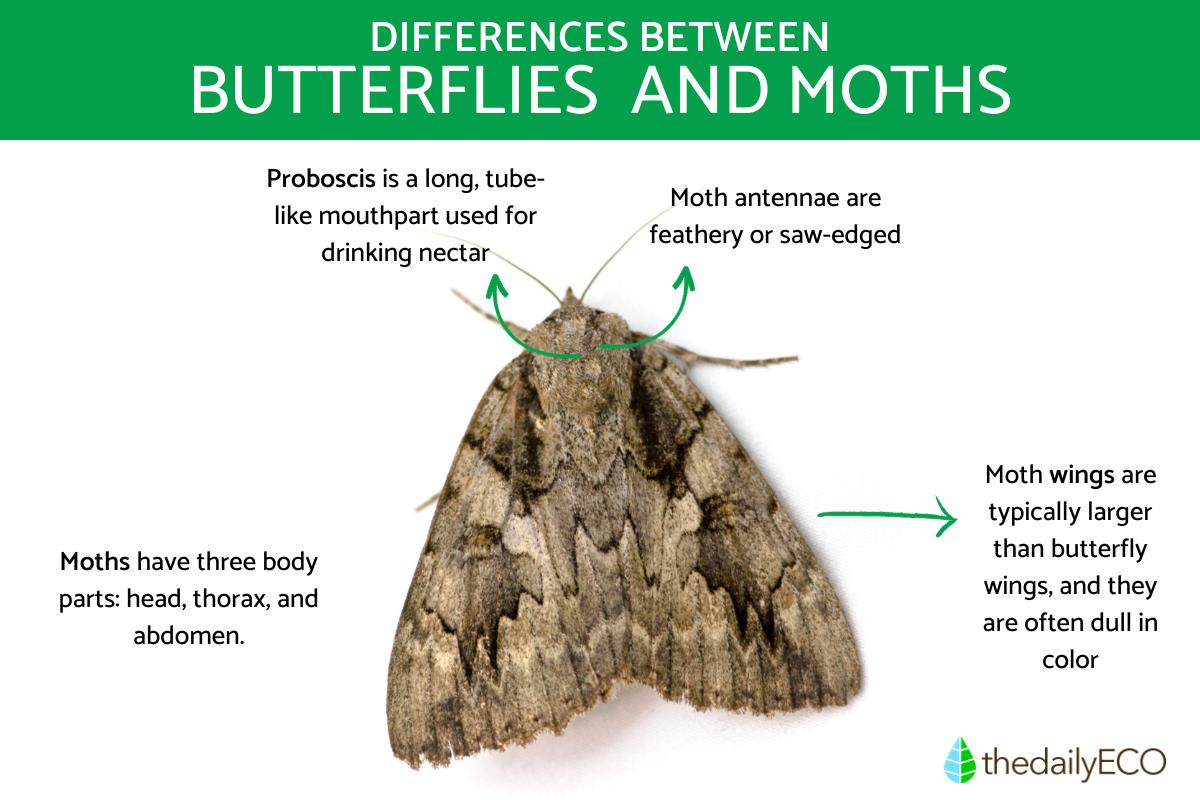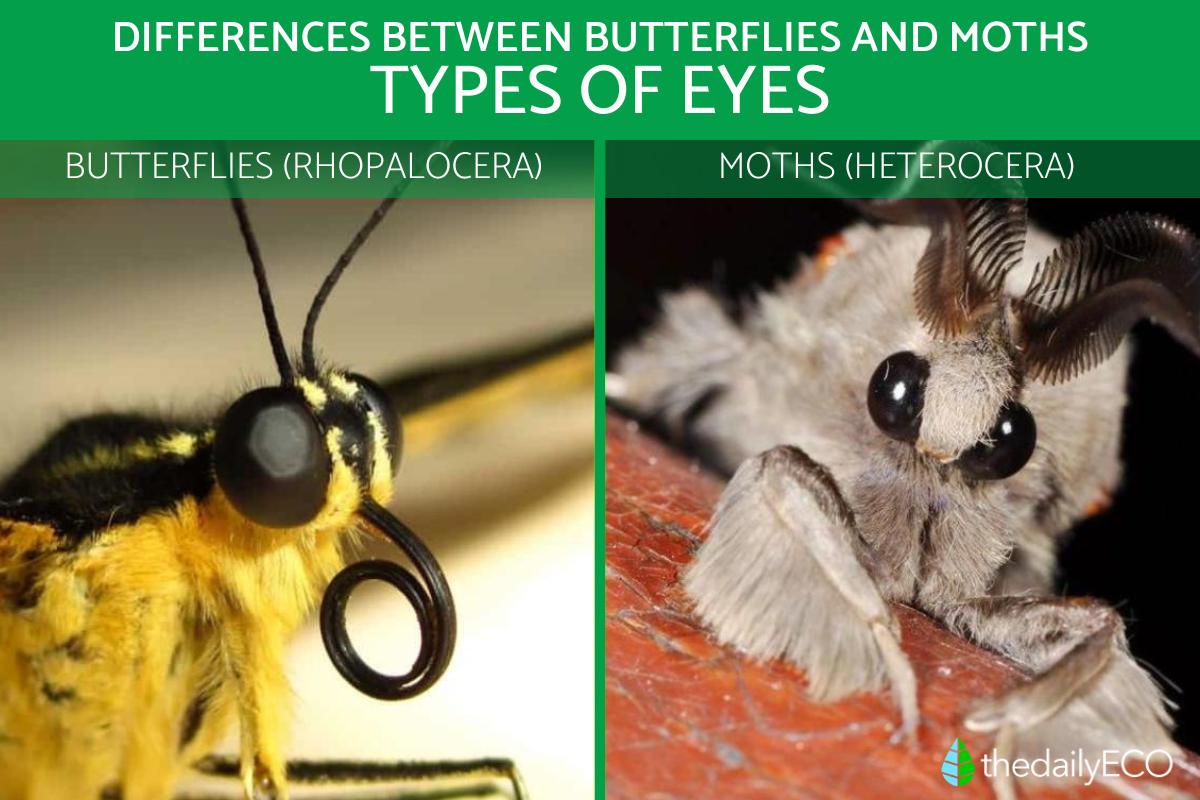Differences Between Butterflies and Moths


Butterflies and moths are among the most cherished and recognizable insects globally. Their vibrant wings and graceful flight patterns bring joy to many. However, while these two insect groups belong to the order Lepidoptera, encompassing over 180,000 described species, they exhibit distinguishing features in their appearance, behaviors, and life cycles, setting them apart from one another.
In this article, we will explore the key differences between butterflies and moths, including their appearance, activity patterns, and life cycles.
What are the general characteristics of a butterfly?
Butterflies are insects that belong to the order Lepidoptera, which also includes moths. Butterflies are known for their beautiful appearance and unique characteristics:
- Antennae and body: butterflies possess club-shaped antennae and exhibit three distinct body parts. Their head is equipped with two large compound eyes, two club-shaped antennae, and a proboscis for drinking nectar. The thorax contains three pairs of legs and two pairs of large, intricately patterned wings, while the abdomen houses essential digestive, reproductive, and respiratory systems.
- Wings: they have four large, often colorful wings covered in tiny scales that give them their vibrant colors and patterns. Butterfly wings, covered in scales, give them their colorful appearance and are fragile and easily damaged if handled roughly.
- Activity time: Butterflies are primarily diurnal, meaning they are active during the day. Most species of butterflies are commonly seen fluttering around in daylight hours, visiting flowers for nectar and engaging in various behaviors such as basking in the sun and mating.
- Metamorphosis: butterflies undergo four stages: egg, caterpillar, pupa, and adult, a transformation known as complete metamorphosis.
- Proboscis: they have a long, coiled tube-like mouthpart used for drinking nectar from flowers.
- Feeding: Adult butterflies mainly feed on flower nectar, while caterpillars eat leaves. They play a key role in pollination.
- Lifespan: The time butterflies live as adults varies by species, lasting from a few weeks to several months.
- Habitat: Butterflies inhabit various environments, including gardens, fields, and forests.
Did you know that butterflies and moths are both important pollinators? To learn more about the other animals that help to pollinate our plants, read our article on pollinators.

Moths, closely akin to butterflies, belong to the same order, Lepidoptera. However, moths outnumber butterflies, with over 160,000 species compared to about 18,500 species of butterflies. Below, we explore some key characteristics that distinguish these fascinating insects:
- Antennae and body: Moths generally have feathery or saw-edged antennae and possess a head with compound eyes, two antennae, and a proboscis for nectar consumption. Their thorax comprises three pairs of legs and two pairs of wings, while the abdomen houses vital systems.
- Wings: Moth wings are usually larger than butterfly wings, with often duller colors. While it is trye that some moths can be brightly colored, many have wings that are more cryptically colored or patterned, aiding them in blending into their surroundings.
- Activity time: Moths are primarily nocturnal, though exceptions exist, with some species active during the day.
- Metamorphosis: like butterflies, moths undergo four stages: egg, caterpillar, pupa, and adult. Moth caterpillars exhibit diverse feeding habits, such as feeding on leaves, wood, or sap.
- Proboscis: this long, tubular mouthpart is used for sipping nectar from flowers and other liquid food sources. The proboscis remains coiled when not in use and is an essential structure for feeding in adult moths.
- Feeding: adult moths typically feed on flower nectar, similar to butterflies. However, caterpillars (larval stage) exhibit varied feeding habits. Some moth caterpillars feed on leaves, while others consume different materials such as wood, sap, or stored products like grains or fabrics. Moths, like butterflies, also contribute to pollination by feeding on nectar and transferring pollen as they visit flowers.
- Lifespan: the adult lifespan of moths, akin to butterflies, varies considerably by species. It can range from a few weeks to several months depending on the specific moth species.
- Habitat: moths tend to prefer dark, damp environments due to their less developed compound eyes, and they're attracted to artificial light to navigate at night.
Did you know that some caterpillars are so poisonous that they can even kill humans? To delve deeper into understanding the most deadly poisonous caterpillars globally and how to ensure safety in their presence, explore our article dedicated to these lethal insects.

Wing position at rest
One of the key differences between moths and butterflies is their wing position at rest:
- Butterflies: butterflies rest with their wings closed and held upright or slightly angled when at rest. Their wings are brought together above their body in a vertical position.
- Moths: moths, on the other hand, rest with their wings open, spread flat, or tent-like over their bodies. While at rest, moths keep their wings outstretched, horizontally or angled over their abdomens. This is a fundamental distinction from butterflies, which tend to rest with their wings upright and closed.

Wing coloration
Butterflies exhibit a morphological difference in wing coloration, diurnal species tend to showcase brighter hues, whereas nocturnal ones often display brown tones.
- Butterflies: butterfly wings often display vibrant, striking, and vivid colors. Their wings are renowned for their brilliant and colorful patterns. Many species exhibit bright and vivid hues, with intricate designs and patterns that are visually appealing.
- Moths: moths' wing coloration tends to be more subtle and muted compared to butterflies. While some moths also have colorful wings, they generally display more earthy or cryptic tones, often with patterns that help them blend into their surroundings. The coloration in moths is typically aimed at providing camouflage and protection rather than being eye-catching.
Types of eyes
When considering the types of eyes in moths and butterflies, one of the primary distinctions lies in the nature of their eyes:
- Butterflies: similar to moths, butterflies typically have compound eyes consisting of numerous ommatidia. These compound eyes contribute to their panoramic vision, aiding in detecting movement and changes in their surroundings. Additionally, butterflies might also possess simple eyes (ocelli) that help in detecting light variations.
- Moths: moths generally possess a variety of eye types, including simple eyes known as ocelli, compound eyes, or both. These insects often have compound eyes composed of multiple ommatidia, which allow them to detect motion and perceive their environment. Additionally, some moths may have ocelli, which are basic eyes capable of sensing light and darkness.
While both moths and butterflies generally have compound eyes, the arrangement and number of ommatidia may vary between species, influencing their visual capabilities and adaptations to their environments.

Body size
In considering the variance between moths and butterflies, one notable distinction lies in their body size:
- Butterflies: in general, butterflies exhibit a relatively more standardized body size among species. Most butterflies have a size range with smaller species having wingspans typically starting at around half an inch and larger species having wingspans that can reach several inches. However, compared to moths, butterflies display less diversity in body size among various species.
- Moths: moths, on average, tend to have more diverse body sizes compared to butterflies. The size of moths varies considerably between species, ranging from tiny moths with wingspans of a few millimeters to larger moth species with wingspans measuring several inches.

Antenna structure
The distinction in the structure of their antennae represents a significant divergence between moths and butterflies.
- Butterflies: butterflies typically possess club-shaped antennae. Their antennae are generally straight with a club-shaped tip, resembling a rounded knob at the end. Unlike the diverse and sometimes intricate structures of moth antennae, butterfly antennae commonly follow this clubbed shape across species.
- Moths: moths commonly feature antennae that are often varied in shape and structure. Many moth species exhibit feathery or saw-edged antennae, contributing to their unique appearance. These antennae can be quite elaborate, with distinct shapes and sizes among different species.
Pupal stage
The life cycle differences between butterflies and moths primarily relate to their pupal stage and the protective casing formed during this phase.
- Butterflies: While many butterfly species indeed form a chrysalis, this casing, made from a tough protein, can be exposed and is distinct from the silk cocoons commonly crafted by moth caterpillars. However, some butterfly species do exhibit variations in their pupal casing formation.
- Moths: they typically create a silk cocoon or chrysalis, which acts as a protective structure for the pupal stage inside.

Attraction to light
One of the notable differences between moths and butterflies is their interaction with artificial light sources:
- Butterflies: in contrast, butterflies are typically less attracted to artificial light sources. They tend to be diurnal and are more active during the day, showing minimal interest in or attraction to artificial lights at night. Unlike moths, butterflies' behavioral patterns are not significantly influenced by light sources after dusk.
- Moths: moths are notably attracted to artificial light sources. They are drawn to and often flutter around lights at night, a behavior known as phototaxis. This attraction to light is so strong that it can sometimes lead to detrimental consequences, such as interference with their natural navigation and survival instincts.
Active cycle
Comparing the activity times of moths and butterflies reveals contrasting behavioral patterns in these insects.
- Butterflies: butterflies are diurnal insects, meaning they are predominantly active during the day. They exhibit peak activity during daylight hours, often fluttering from flower to flower, basking in the sun, feeding on nectar, and engaging in mating behaviors. Their flight and feeding patterns are notably active during the daytime.
- Moths: moths are primarily nocturnal insects, meaning they are active during the night. They often emerge and are most active after dusk, flying, feeding, and engaging in their various behaviors during the nighttime hours. While most moths are nocturnal, there are exceptions, and some moth species are diurnal, being active during the day.
Did you know that, like fireflies, some moths can also produce light? To learn more about how fireflies and moths produce light, and the different ways they use it, check out our other article.
If you want to read similar articles to Differences Between Butterflies and Moths, we recommend you visit our Facts about animals category.
- Adrián Agea, R. (2013). Pilot study on the influence of artificial light on the abundance of moth and moth species in San Cristóbal, Galapagos ( Bachelor's thesis, Quito: USFQ, 2013).
- Beatty, R., Beer, A., & Deeming, C. (2010). The book of nature. Great Britain: Dorling Kindersley.











